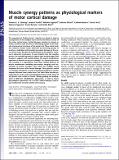Muscle synergy patterns as physiological markers of motor cortical damage
Author(s)
Cheung, Vincent Chi-Kwan; Turolla, Andrea; Agostini, Michela; Silvoni, Stefano; Bennis, Caoimhe; Kasi, Patrick; Paganoni, Sabrina; Bonato, Paolo; Bizzi, Emilio; ... Show more Show less
DownloadCheung-2012-Muscle synergy patte.pdf (723.1Kb)
PUBLISHER_POLICY
Publisher Policy
Article is made available in accordance with the publisher's policy and may be subject to US copyright law. Please refer to the publisher's site for terms of use.
Terms of use
Metadata
Show full item recordAbstract
The experimental findings herein reported are aimed at gaining a perspective on the complex neural events that follow lesions of the motor cortical areas. Cortical damage, whether by trauma or stroke, interferes with the flow of descending signals to the modular interneuronal structures of the spinal cord. These spinal modules subserve normal motor behaviors by activating groups of muscles as individual units (muscle synergies). Damage to the motor cortical areas disrupts the orchestration of the modules, resulting in abnormal movements. To gain insights into this complex process, we recorded myoelectric signals from multiple upper-limb muscles in subjects with cortical lesions. We used a factorization algorithm to identify the muscle synergies. Our factorization analysis revealed, in a quantitative way, three distinct patterns of muscle coordination—including preservation, merging, and fractionation of muscle synergies—that reflect the multiple neural responses that occur after cortical damage. These patterns varied as a function of both the severity of functional impairment and the temporal distance from stroke onset. We think these muscle-synergy patterns can be used as physiological markers of the status of any patient with stroke or trauma, thereby guiding the development of different rehabilitation approaches, as well as future physiological experiments for a further understanding of postinjury mechanisms of motor control and recovery.
Date issued
2012-08Department
McGovern Institute for Brain Research at MITJournal
Proceedings of the National Academy of Sciences of the United States of America
Publisher
National Academy of Sciences (U.S.)
Citation
Cheung, V. C. K. et al. “Muscle Synergy Patterns as Physiological Markers of Motor Cortical Damage.” Proceedings of the National Academy of Sciences 109.36 (2012): 14652–14656. ©2012 National Academy of Sciences
Version: Final published version
ISSN
0027-8424
1091-6490